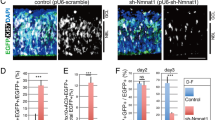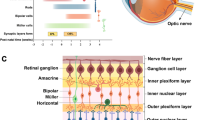Abstract
Histone post-translational modification has been shown to play a pivotal role in regulating gene expression and fate determination during the development of the central nervous system. Application of pharmacological blockers that control histone methylation status has been considered a promising avenue to control abnormal developmental processes and diseases as well. In this study, we focused on the role of potent histone demethylase inhibitor GSK-J1 as a blocker of Jumonji domain-containing protein 3 (Jmjd3) in early postnatal retinal development. Jmjd3 participates in different processes such as cell proliferation, apoptosis, differentiation, senescence, and cell reprogramming via demethylation of histone 3 lysine 27 trimethylation status (H3K27 me3). As a first approach, we determined the localization of Jmjd3 in neonate and adult rat retina. We observed that Jmjd3 accumulation is higher in the adult retina, which is consistent with the localization in the differentiated neurons, including ganglion cells in the retina of neonate rats. At this developmental age, we also observed the presence of Jmjd3 in undifferentiated cells. Also, we confirmed that GSK-J1 caused the increase in the H3k27 me3 levels in the retinas of neonate rats. We next examined the functional consequences of GSK-J1 treatment on retinal development. Interestingly, injection of GSK-J1 simultaneously increased the number of proliferative and apoptotic cells. Furthermore, an increased number of immature cells were detected in the outer plexiform layer, with longer neuronal processes. Finally, the influence of GSK-J1 on postnatal retinal cytogenesis was examined. Interestingly, GSK-J1 specifically caused a significant decrease in the number of PKCα-positive cells, which is a reliable marker of rod-on bipolar cells, showing no significant effects on the differentiation of other retinal subtypes. To our knowledge, these data provide the first evidence that in vivo pharmacological blocking of histone demethylase by GSK-J1 affects differentiation of specific neuronal subtypes. In summary, our results indisputably revealed that the application of GSK-J1 could influence cell proliferation, maturation, apoptosis induction, and specific cell determination. With this, we were able to provide evidence that this small molecule can be explored in therapeutic strategies for the abnormal development and diseases of the central nervous system.








Similar content being viewed by others
References
Seung HS, Sumbul U (2014) Neuronal cell types and connectivity: lessons from the retina. Neuron 83(6):1262–1272. https://doi.org/10.1016/j.neuron.2014.08.054
Bassett EA, Wallace VA (2012) Cell fate determination in the vertebrate retina. Trends Neurosci 35(9):565–573. https://doi.org/10.1016/j.tins.2012.05.004
Laugesen A, Helin K (2014) Chromatin repressive complexes in stem cells, development, and cancer. Cell Stem Cell 14(6):735–751. https://doi.org/10.1016/j.stem.2014.05.006
Aldiri I, Xu B, Wang L, Chen X, Hiler D, Griffiths L, Valentine M, Shirinifard A et al (2017) The dynamic epigenetic landscape of the retina during development, reprogramming, and tumorigenesis. Neuron 94(3):550–568 e510. https://doi.org/10.1016/j.neuron.2017.04.022
Seritrakul P, Gross JM (2017) Tet-mediated DNA hydroxymethylation regulates retinal neurogenesis by modulating cell-extrinsic signaling pathways. PLoS Genet 13(9):e1006987. https://doi.org/10.1371/journal.pgen.1006987
Bowman GD, Poirier MG (2015) Post-translational modifications of histones that influence nucleosome dynamics. Chem Rev 115(6):2274–2295. https://doi.org/10.1021/cr500350x
Prabakaran S, Lippens G, Steen H, Gunawardena J (2012) Post-translational modification: nature’s escape from genetic imprisonment and the basis for dynamic information encoding. Wiley Interdiscip Rev Syst Biol Med 4(6):565–583. https://doi.org/10.1002/wsbm.1185
Bannister AJ, Kouzarides T (2011) Regulation of chromatin by histone modifications. Cell Res 21(3):381–395. https://doi.org/10.1038/cr.2011.22
Kooistra SM, Helin K (2012) Molecular mechanisms and potential functions of histone demethylases. Nat Rev Mol Cell Biol 13(5):297–311. https://doi.org/10.1038/nrm3327
Hansen KH, Bracken AP, Pasini D, Dietrich N, Gehani SS, Monrad A, Rappsilber J, Lerdrup M et al (2008) A model for transmission of the H3K27me3 epigenetic mark. Nat Cell Biol 10(11):1291–1300. https://doi.org/10.1038/ncb1787
Margueron R, Reinberg D (2011) The polycomb complex PRC2 and its mark in life. Nature 469(7330):343–349. https://doi.org/10.1038/nature09784
Iida A, Iwagawa T, Baba Y, Satoh S, Mochizuki Y, Nakauchi H, Furukawa T, Koseki H et al (2015) Roles of histone H3K27 trimethylase Ezh2 in retinal proliferation and differentiation. Dev Neurobiol 75(9):947–960. https://doi.org/10.1002/dneu.22261
Aldiri I, Moore KB, Hutcheson DA, Zhang J, Vetter ML (2013) Polycomb repressive complex PRC2 regulates Xenopus retina development downstream of Wnt/beta-catenin signaling. Development 140(14):2867–2878. https://doi.org/10.1242/dev.088096
Zhang J, Taylor RJ, La Torre A, Wilken MS, Cox KE, Reh TA, Vetter ML (2015) Ezh2 maintains retinal progenitor proliferation, transcriptional integrity, and the timing of late differentiation. Dev Biol 403(2):128–138. https://doi.org/10.1016/j.ydbio.2015.05.010
Swigut T, Wysocka J (2007) H3K27 demethylases, at long last. Cell 131(1):29–32. https://doi.org/10.1016/j.cell.2007.09.026
Park DH, Hong SJ, Salinas RD, Liu SJ, Sun SW, Sgualdino J, Testa G, Matzuk MM et al (2014) Activation of neuronal gene expression by the JMJD3 demethylase is required for postnatal and adult brain neurogenesis. Cell Rep 8(5):1290–1299. https://doi.org/10.1016/j.celrep.2014.07.060
Burgold T, Spreafico F, De Santa F, Totaro MG, Prosperini E, Natoli G, Testa G (2008) The histone H3 lysine 27-specific demethylase Jmjd3 is required for neural commitment. PLoS One 3(8):e3034. https://doi.org/10.1371/journal.pone.0003034
Iida A, Iwagawa T, Kuribayashi H, Satoh S, Mochizuki Y, Baba Y, Nakauchi H, Furukawa T et al (2014) Histone demethylase Jmjd3 is required for the development of subsets of retinal bipolar cells. Proc Natl Acad Sci U S A 111(10):3751–3756. https://doi.org/10.1073/pnas.1311480111
Tough DF, Tak PP, Tarakhovsky A, Prinjha RK (2016) Epigenetic drug discovery: breaking through the immune barrier. Nat Rev Drug Discov 15(12):835–853. https://doi.org/10.1038/nrd.2016.185
Becker S, Wang H, Stoddard GJ, Hartnett ME (2017) Effect of subretinal injection on retinal structure and function in a rat oxygen-induced retinopathy model. Mol Vis 23:832–843
Kihara AH, Santos TO, Paschon V, Matos RJ, Britto LR (2008) Lack of photoreceptor signaling alters the expression of specific synaptic proteins in the retina. Neuroscience 151(4):995–1005. https://doi.org/10.1016/j.neuroscience.2007.09.088
Dunn KW, Kamocka MM, McDonald JH (2011) A practical guide to evaluating colocalization in biological microscopy. Am J Physiol Cell Physiol 300(4):C723–C742. https://doi.org/10.1152/ajpcell.00462.2010
Rao MS, Shetty AK (2004) Efficacy of doublecortin as a marker to analyse the absolute number and dendritic growth of newly generated neurons in the adult dentate gyrus. Eur J Neurosci 19(2):234–246
Dekker FJ, van den Bosch T, Martin NI (2014) Small molecule inhibitors of histone acetyltransferases and deacetylases are potential drugs for inflammatory diseases. Drug Discov Today 19(5):654–660. https://doi.org/10.1016/j.drudis.2013.11.012
Mackeen MM, Kramer HB, Chang KH, Coleman ML, Hopkinson RJ, Schofield CJ, Kessler BM (2010) Small-molecule-based inhibition of histone demethylation in cells assessed by quantitative mass spectrometry. J Proteome Res 9(8):4082–4092. https://doi.org/10.1021/pr100269b
Heinemann B, Nielsen JM, Hudlebusch HR, Lees MJ, Larsen DV, Boesen T, Labelle M, Gerlach LO et al (2014) Inhibition of demethylases by GSK-J1/J4. Nature 514(7520):E1–E2. https://doi.org/10.1038/nature13688
Kruidenier L, Chung CW, Cheng Z, Liddle J, Che K, Joberty G, Bantscheff M, Bountra C et al (2012) A selective jumonji H3K27 demethylase inhibitor modulates the proinflammatory macrophage response. Nature 488(7411):404–408. https://doi.org/10.1038/nature11262
Bao B, He Y, Tang D, Li W, Li H (2017) Inhibition of H3K27me3 histone demethylase activity prevents the proliferative regeneration of zebrafish lateral line neuromasts. Front Mol Neurosci 10:51. https://doi.org/10.3389/fnmol.2017.00051
Yang D, Okamura H, Teramachi J, Haneji T (2015) Histone demethylase Utx regulates differentiation and mineralization in osteoblasts. J Cell Biochem 116(11):2628–2636. https://doi.org/10.1002/jcb.25210
Zhang F, Xu L, Xu L, Xu Q, Li D, Yang Y, Karsenty G, Chen CD (2015) JMJD3 promotes chondrocyte proliferation and hypertrophy during endochondral bone formation in mice. J Mol Cell Biol 7(1):23–34. https://doi.org/10.1093/jmcb/mjv003
Tang B, Qi G, Tang F, Yuan S, Wang Z, Liang X, Li B, Yu S et al (2016) Aberrant JMJD3 expression upregulates slug to promote migration, invasion, and stem cell-like behaviors in hepatocellular carcinoma. Cancer Res 76(22):6520–6532. https://doi.org/10.1158/0008-5472.CAN-15-3029
Zhao L, Zhang Y, Gao Y, Geng P, Lu Y, Liu X, Yao R, Hou P et al (2015) JMJD3 promotes SAHF formation in senescent WI38 cells by triggering an interplay between demethylation and phosphorylation of RB protein. Cell Death Differ 22(10):1630–1640. https://doi.org/10.1038/cdd.2015.6
Zhao W, Li Q, Ayers S, Gu Y, Shi Z, Zhu Q, Chen Y, Wang HY et al (2013) Jmjd3 inhibits reprogramming by upregulating expression of INK4a/Arf and targeting PHF20 for ubiquitination. Cell 152(5):1037–1050. https://doi.org/10.1016/j.cell.2013.02.006
Tokunaga R, Sakamoto Y, Nakagawa S, Miyake K, Izumi D, Kosumi K, Taki K, Higashi T et al (2016) The prognostic significance of histone lysine demethylase JMJD3/KDM6B in colorectal cancer. Ann Surg Oncol 23(2):678–685. https://doi.org/10.1245/s10434-015-4879-3
Mu X, Fu X, Sun H, Liang S, Maeda H, Frishman LJ, Klein WH (2005) Ganglion cells are required for normal progenitor—cell proliferation but not cell-fate determination or patterning in the developing mouse retina. Curr Biol 15(6):525–530. https://doi.org/10.1016/j.cub.2005.01.043
Sui A, Xu Y, Li Y, Hu Q, Wang Z, Zhang H, Yang J, Guo X et al (2017) The pharmacological role of histone demethylase JMJD3 inhibitor GSK-J4 on glioma cells. Oncotarget 8(40):68591–68598. https://doi.org/10.18632/oncotarget.19793
Zhang Y, Shen L, Stupack DG, Bai N, Xun J, Ren G, Han J, Li L et al (2016) JMJD3 promotes survival of diffuse large B-cell lymphoma subtypes via distinct mechanisms. Oncotarget 7(20):29387–29399. https://doi.org/10.18632/oncotarget.8836
Morozov VM, Li Y, Clowers MM, Ishov AM (2017) Inhibitor of H3K27 demethylase JMJD3/UTX GSK-J4 is a potential therapeutic option for castration resistant prostate cancer. Oncotarget 8(37):62131–62142. https://doi.org/10.18632/oncotarget.19100
Dyer MA, Cepko CL (2001) Regulating proliferation during retinal development. Nat Rev Neurosci 2(5):333–342. https://doi.org/10.1038/35072555
Reiner O, Coquelle FM, Peter B, Levy T, Kaplan A, Sapir T, Orr I, Barkai N et al (2006) The evolving doublecortin (DCX) superfamily. BMC Genomics 7:188. https://doi.org/10.1186/1471-2164-7-188
Martins RA, Pearson RA (2008) Control of cell proliferation by neurotransmitters in the developing vertebrate retina. Brain Res 1192:37–60. https://doi.org/10.1016/j.brainres.2007.04.076
Das A, Arifuzzaman S, Yoon T, Kim SH, Chai JC, Lee YS, Jung KH, Chai YG (2017) RNA sequencing reveals resistance of TLR4 ligand-activated microglial cells to inflammation mediated by the selective jumonji H3K27 demethylase inhibitor. Sci Rep 7(1):6554. https://doi.org/10.1038/s41598-017-06914-5
Donas C, Carrasco M, Fritz M, Prado C, Tejon G, Osorio-Barrios F, Manriquez V, Reyes P et al (2016) The histone demethylase inhibitor GSK-J4 limits inflammation through the induction of a tolerogenic phenotype on DCs. J Autoimmun 75:105–117. https://doi.org/10.1016/j.jaut.2016.07.011
Madeira MH, Boia R, Santos PF, Ambrosio AF, Santiago AR (2015) Contribution of microglia-mediated neuroinflammation to retinal degenerative diseases. Mediat Inflamm 2015:673090. https://doi.org/10.1155/2015/673090
Acknowledgments
We are grateful to Erika Reime Kinjo, Guilherme Shigueto Vilar Higa, and Vera Paschon, Neurogenetics Lab assistants, Animal Facility, at Federal University of ABC.
Funding
This research was supported by Fundação de Amparo à Pesquisa do Estado de São Paulo (FAPESP, #2013/07458-2, #2014/16711-6, #2015/04495-0, #2017/26439-0), Conselho Nacional de Desenvolvimento Científico e Tecnológico (CNPq, #431000/2016-6, #308608/2014-3), and Universidade Federal do ABC (UFABC).
Author information
Authors and Affiliations
Corresponding author
Ethics declarations
The experiments on animals were conducted considering the guidelines of the NIH and the Brazilian Society for Laboratory Animals. The experimental protocol (9965240217) was approved by the Ethics Committee of Federal University of ABC.
Rights and permissions
About this article
Cite this article
Raeisossadati, R., Móvio, M.I., Walter, L.T. et al. Small Molecule GSK-J1 Affects Differentiation of Specific Neuronal Subtypes in Developing Rat Retina. Mol Neurobiol 56, 1972–1983 (2019). https://doi.org/10.1007/s12035-018-1197-3
Received:
Accepted:
Published:
Issue Date:
DOI: https://doi.org/10.1007/s12035-018-1197-3




